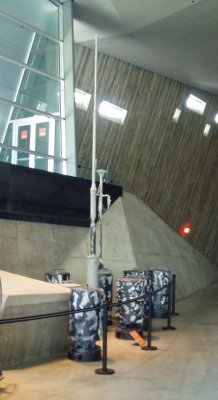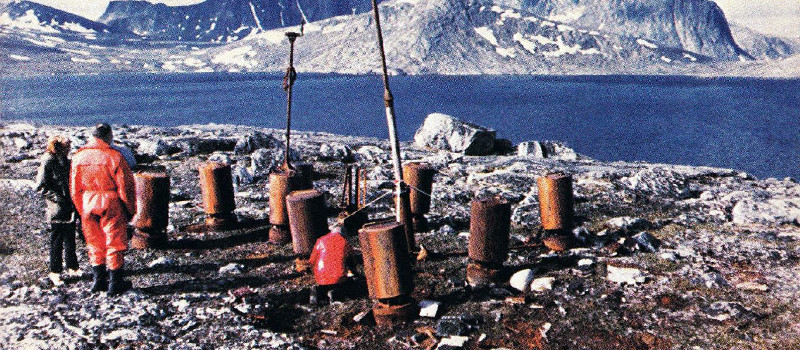Sometimes when researching one Hackaday story we as writers stumble upon the one train of thought that leads to another. So it was with a recent look at an unmanned weather station buoy from the 1960s, which took us on a link to a much earlier automated weather station.

Weather Station Kurt was the only successful installation among a bold attempt by the German military during the Second World War to gain automated real-time meteorological data from the Western side of the Atlantic. Behind that simple sentence hides an extremely impressive technical and military achievement for its day. This was the only land-based armed incursion onto the North American continent by the German military during the entire war. Surrounded as it was though by secrecy, and taking place without conflict in an extremely remote part of Northern Labrador, it passed unnoticed by the Canadian authorities and was soon forgotten as an unimportant footnote in the wider conflagration.
Kurt took the form of a series of canisters containing a large quantity of nickel-cadmium batteries, meteorological instruments, a telemetry system, and a 150W high frequency transmitter. In addition there was a mast carrying wind speed and direction instruments, and the transmitting antenna. In use it was to have provided vital advance warning of weather fronts from the Western Atlantic as they proceeded towards the European theatre of war, the establishment of a manned station on enemy territory being too hazardous.
A small number of these automated weather stations were constructed by Siemens in 1943, and it was one of them which was dispatched in the U-boat U537 for installation on the remote Atlantic coast of what is now part of modern-day Canada. In late October 1943 they succeeded in that task after a hazardous trans-Atlantic voyage, leaving the station bearing the markings of the non-existent “Canadian Meteor Service” in an attempt to deceive anybody who might chance upon it. In the event it was not until 1977 that it was spotted by a geologist, and in 1981 it was retrieved and taken to the Canadian War Museum.
There is frustratingly little information to be found on the exact workings on the telemetry system, save that it made a transmission every few hours on 3940kHz. A Google Books result mentions that the transmission was encoded in Morse code using the enigmatic Graw’s Diaphragm, a “sophisticated contact drum” named after a Dr. [Graw], from Berlin. It’s a forgotten piece of technology that defies our Google-fu in 2017, but it must in effect have been something of a mechanical analogue-to-digital converter.
Should you happen to be visiting the Canadian capital, you can see Kurt on display in the Canadian War Museum. It appears to have been extensively restored from the rusty state it appears in the photograph taken during its retrieval, it would be interesting to know whether anything remains of the Graw’s Diaphragm. Do any readers know how this part of the station worked? Please let us know in the comments.
Weather station Kurt retrieval image, Canadian National Archives. (Public domain).
Weather station Kurt in museum image, SimonP (Public domain).
















The description of the Graw’s Diaphragm remunds me of the encoding mechanism used in Hellschreiber (https://www.nonstopsystems.com/radio/hellschreiber-function-operation.htm). I’m guessing that a similar mechanism would be used to encode each digit, but a solonoid would be used instead of a key, and the solonoid would be enabled by the drum encoding the previous character/digit.
Why weren’t those with radios in the great U.S. of A. picking up the signal?
Considering that a large portion of radio signals transmitted during that time frame were in Morse code or some other code, and that a many additional radio stations came on the air (military communications, land, air, and sea, from many different groups on both sides, would make it difficult to find anything of interest in a “random” signals from a place that held no strategic value. If the enemy were invading, they’d find a place that wasn’t so difficult to get in or out of…
… and the cost of sending someone to northern Labrador to find the location and reason for such transmissions, when manpower and other resources was short in North America during the war.
Also, not continuous transmission so it is harder to stumble across/trace.
If you click through to the museum’s page on Kurt, it says that the device failed after a few days, and only broadcasted every three hours.
Just a wild guess…
what if a control arm was moved across the surface of a rotating drum, with various Morse codes on it (such as pits and bumps) in tracks around the drum, each track encoded for a particular number/range, and the control arm was moved to each track by an analog means, such as a speedometer needle for wind speed, or a diaphragm for atmospheric pressure, or a bi-metal strip for temperature…
Maybe 3 such drums, one for each parameter, fed sequentially into the transmitter, (I think a simple mechanical switch could activate the next drum when a drum finished its portion of the message).
A mechanical ROM.
It was kind of neat to find that my “wild guess” had some similarity to Dr. Graw’s patents (posted by later commenters). Or, had I previously seen something similar and dug it out of the foggy recesses of my mind.
Some information on the encoder can be found if you search for the german name: “Grawsche Morsewalze” especially on this site: https://web.archive.org/web/20140924002922/http://www.radiosonde.eu/RS01/RS01C75.html Unfortunately the photos are no longer to be found. Josef Graw was a german physicist who developed a lot of radio beacons for meteorological purposes. The company he founded exists up until today: http://www.graw.de/
Ah I found a photography of the Morsewalze: http://www.graw.de/fileadmin/user_graw_upload/history/morsewalze_b520px_72dpi.png
If you mean the embedded photos, they show for me. Quite informative, in fact.
Doctor Josef Graw morse encoding cylinder for radio balloon telemetry. The components look like
this http://www.radiosonde.eu.bonplans.info/RS03/RS03V/RS03V10.html
more detail on the coding and drum http://www.radiosonde.eu.bonplans.info/RS01/RS01C71.html
It wasn’t the only incursion by the Germans in North America. Two teams of saboteurs were put ashore in the USA by German submarines. http://www.historynet.com/world-war-ii-german-saboteurs-invade-america-in-1942.htm
This patent application seems to describe the mechanisms in quite a lot of detail, in the inventor’s own words (Dr. Josef Graf): https://www.google.ch/patents/US2939127
Was there a frame format? Like, preamble at the beginning for time t1, identifying start of the readout, then Morse code encoded readout generated by Graw’s diaphragm #1, for time t2, then interlude (or identification/numeration of the next readout) for time t3, then next readout, … etc. , in other words, was the information multiplexed in time, or perhaps it was frequency-multiplexed, i.e. each readout had it’s own frequency?
Thank you to all of you who have found details of the different Graw mechanisms. You have put me rather to shame, but delivered a bunch of fascinating reads.
Interesting article — and as a Canadian, this was a story I’ve never heard before.
Perhaps nit-picking but it may not have been the responsibility of Canadian authorities to detect or police a location like this during WW2, as at that time, Labrador was part of an overseas colony of Britain and was governed by a panel of British appointees. It had trade and communications links to Canada but wasn’t part of, or controlled by, Canada.
Labrador is incredibly remote and sparsely populated. It is about the size of the UK but only 30,000 people live there — and 2/3rds of those 30,000 live in two small urban areas.
But they produce great dogs!
B^)
Reminds me of little known USSR external combustion thermonuclear powered weather stations. Now I am reading that the devices were lighthouses and beacons and not external combustion. I thought they were air medium basically sterling cycle engines or at least designed to operate once the other medium leaked out, i.e. hydrogen helium. HHhmmm…
I recall reading on the PesWiki site which looks to be down and with bad news. https://rationalwiki.org/wiki/PESWiki I know some of the technology presented was valid and a lot was strange most likely not, or perceived as not, more efficient or renewable/recyclable/restore able. That is where I first learned about Arc Furnaces that advance to ICP self powered if enough hydrocarbon waste gasification units other than when maintenance cycles were needed and that is what I thought would be the effective improvement on design. Algae for solar production of hydrocarbon fuel and other external combustion technology as well as geothermal and even earth batteries. Kind of juvenile story time in some cases though inspirational for boundary of science goals to see if feasible some ways and means.
Well, after a lazy search on the web… I find the devices are being found as not external combustion… they’re more Seebeck or solid state like design.
https://en.wikipedia.org/wiki/Radioisotope_thermoelectric_generator
Interesting regarding a Canadian first (circa 1961): https://www.cns-snc.ca/media/history/ArcticWeatherStation.pdf
“external combustion” and “thermonuclear” do not work together.
External combustion is burning something (coal, oil, gas, wood, …) to produce steam which then moves turbines or cylinders. Thermonuclear is using radioactive decay (or fission) as heat source, with hopefully nothing burning.
For a hands-off system you will want to choose something that cannot misbehave, so you will either need some nuclear reactor design that is inherently safe (i.e. if the temperature rises, the fission rate is reduced due some inherent physical effect — or your design cannot go critical, ever).
Yes, such reactors exist — in fact, most reactors have some self-regulation. Pressurized water reactors and boiling water reactors use the water as a moderator, if it turns to steam, less moderation means less fission.
Would be interesting if a “commemorative” weather station transmitting weather data via APRS was placed at that location. A short alternate beacon about the historical significance of the location could be sent as well.
I’d be very supportive of this. As the operator of a university weather station network, such an effort would really contribute to science and history…Time to look into this
I just noticed no reference from a later article ( https://hackaday.com/2017/12/08/radiosondes/ ) a question in this article that was not clearly answered though “lethalpopcorn” referenced (use Google or Google Chrome translate if you don’t know how to):
https://web.archive.org/web/20140924002922/http://www.radiosonde.eu/RS01/RS01C75.html
http://www.radiosonde.eu.bonplans.info/RS03/RS03V/RS03V10.html
https://hackaday.com/2016/07/04/retrotechtacular-dc-to-dc-conversion-by-vibrator/
You’d think they’d use Gauss Code instead of Morse Code? :-)
I also wonder about “successful installations” during and post WWII POW’s influence on degenerating the U.S. and Allies with their destructive propaganda, lifestyle, behaviors, acts and events influence.